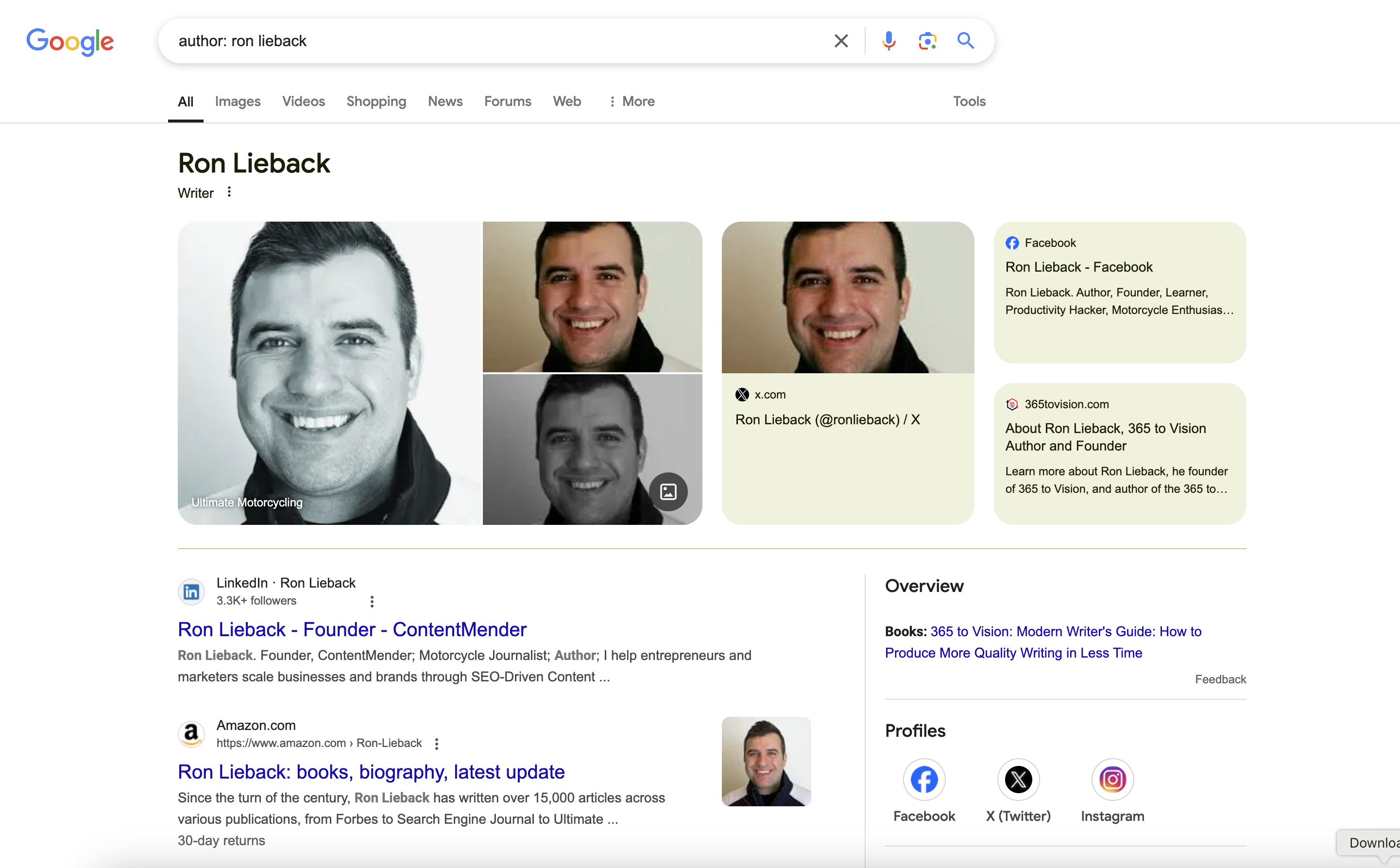It’s no secret that “black hats” and spammy SEO firms have given the industry a bad name in the past.
In the age of AI, this constant barrage of internet spam will only worsen.
Google’s response to misinformation and spam has emphasized author experience, expertise, authority, and trust (E-E-A-T) when evaluating content for search results.
These search-rater guidelines make content expertise and research more important than ever. However, consistent authorship can also give writers a leg up and establish trust within Google’s index.
That’s why the team at ContentMender prioritizes human-written content from experts in the field and also encourages our writers to build out content under their own authorship.
While E-E-A-T largely conforms to existing SEO best practices, we can glean some valuable insights from these guidelines to improve our content and rank higher in search results.
And, the other benefit of writing with E-E-A-T in mind? It’ll also help you gain top spots in AI-driven searches like ChatGPT. These principles work across all search engines—not just Google.

What is Google E-E-A-T?
E-E-A-T is short for “Experience, Expertise, Authoritativeness, and Trustworthiness.” Google E-E-A-T is a set of Search Quality Evaluation Guidelines (SQEG) the algorithm uses to determine what content should rank highest in its search results. While not a direct ranking factor, it influences how Google approaches how it ranks and sorts through content.
It’s no secret that the way we interact with search engines has changed greatly over the last decade. Users expect fast and accurate results for their questions or inquiries, and Google has changed its algorithm to reflect these changes best.
New developments, such as AI-based results and the prominence of “People also ask,” reflect these changes as they attempt to provide as much information as possible without even requiring a click-through to your website.
However, whether users are clicking through to native website pages or getting all of their information straight from the search engine results page, it’s essential that Google provides the best results possible.
This is where E-E-A-T comes in. Despite the advances in machine learning and large language models (LLMs), Google still relies on certain clues to determine the best search results. In the past, this gave special prominence to backlinks, which indicated that something must be valuable if everyone is linking to it.
Nowadays, E-E-A-T informs us how Google uses certain clues to order its results.
- Experience: The writer or producer of the content has direct, first-hand knowledge of the subject. This could involve writing in the first person, submitting user-generated content, or filling out your author bio with strategic keywords.
- Expertise: The content is accurate and demonstrates the author’s expertise on the subject matter. Writers should incorporate lots of high-level, quality sources within content or display credentials to showcase expertise.
- Authority: The author or website has published lots of content on the subject matter in the past and demonstrates thought leadership. Consistency is key to building authority and credibility.
- Trustworthy: The holy grail of it all–Google will only rank content from websites or authors it trusts. To build trust, you must demonstrate experience, expertise, and authority! Note: This is why it takes so long for new websites to rank on Google; they need to establish trust first.
E-E-A-T sounds simple enough in theory, but how does it work in practice?
How Does Google Measure E-E-A-T?
While there is no direct E-E-A-T algorithm, Google provides four categories of E-E-A-T it considers when evaluating content in its Search Quality Rater Guidelines.
- Lowest E-E-A-T: Pages that are actively spammy or harmful to users.
- Lacking E-E-A-T: Content that is written by somebody with little experience or expertise on a subject matter. For example, this could include a scientific paper written with inaccuracies or a movie review written by somebody who has never posted a movie review online before.
- High E-E-A-T: Content that is written by somebody with first-hand experience or knowledge on a subject. This could include user-generated content, a food recipe from somebody with a food blog, or a forum post from somebody actively engaged in that community.
- Very High E-E-A-T: Content written by somebody who is considered a thought leader or expert on a subject. According to Google, “A content creator with a wealth of experience may be considered to have very high E-E-A-T for topics where experience is the primary factor in trust.”
Much of these guidelines justify existing SEO best practices, including the importance of external/internal linking, evergreen content, and using quotes/sources from high-level experts.
However, we will show you a few additional strategies to help your content better rank for E-E-A-T and build more trust with Google.
9 Ways to Improve Your Content to Satisfy Google E-E-A-T Guidelines
Whether you’re trying to reassess and improve existing content or you’re working to create brand new content that satisfies Google’s E-E-A-T guidelines, we have a few tricks that will help you rank higher.
1. Create an Author Tag and Bio
Author tags have long been the subject of discussion in the SEO industry, but in the age of E-E-A-T, they are more important than ever.
Google actively indexes content under your authorship, which you can view if you conduct an “author: name” search.

Having that author tag with topical content under your name will help establish authority, experience, and expertise with Google and help you conform to E-E-A-T guidelines.
Optimize all author tags across any websites you publish on to include past writings and topics you frequently write about.
As a bonus, we have also found that this strategy works extremely well when helping your content rank for AI-based search results on ChatGPT and Perplexity.
2. Write Consistent Content on a Select Handful of Topics
About every beginner SEO guide offers the same advice: start out in a niche field and scale from there.
When it comes to E-E-A-T, the same principle applies. If your website has a hundred blogs on Crossfit and you randomly write a blog about electric vehicles, Google is not likely to rank that piece of content high because why would they trust you to be an expert on that subject?
Again, the keyword is consistency. You should not only be hammering away at the same topics within your field but also writing consistently about them to build trust and authority.
3. Prioritize Longform Evergreen Content
To spam or not to spam—that is the question. But the answer is not to spam.
When it comes to creating content, quality always trumps quantity, especially in the age of E-E-A-T. According to Backlinko, the mean word count of a first-page search result link was around 1,447 words.
Of course, this doesn’t mean you have to chase high word counts for the sake of it, but you do want to create content that is educational and valuable. Ideally, this would be content that answers as many user questions as possible.
4. Optimize for Answer Boxed and Featured Snippets
Answer Box optimization and featured snippets aim to provide users with concise and accurate answers to their questions. While we’ve already stressed the importance of creating educational content, we have found a few additional strategies helpful when ranking for E-A-T-T, answer boxes, and featured snippets.
First, use your keyword research to find several semantically similar keywords and question keywords that you can incorporate into your content. Then, use header tags to divide your content into subcategories that answer as many questions as possible. This strategy also makes your content more scannable.
Secondly, we suggest ending all content with a set of FAQs that provide quick and direct answers to common user questions and help summarize the piece at large.
Lastly, from a strategic perspective, we recommend creating content clusters so that you can tackle subtopics within evergreen pieces in a separate article and link back between the two.
5. Use High-Level Sources and Consistent Links
In all of our blogs, we like to incorporate a minimum of two high-level external backlinks from trusted domains as source material. This not only showcases accurate research to Google but also provides value to users.
In addition, we suggest using lots of internal links to similar content throughout your posts to help establish trust with Google and provide users with additional context.
6. Incorporate User-Generated Content and Quotes
Google’s E-E-A-T guidelines emphasize first-hand experience in content, so incorporating user-generated content is the perfect strategy to optimize this. For example, if you are an automotive parts manufacturer, inserting a review or a story from someone who has used your product can help foster more trust with users and the algorithm.
Another strategy is to conduct interviews with experts in your field or publish roundtable discussions with a panel of experts on a topic related to your industry on your website.
7. Use First-Person Perspective
While many people have frowned on the first-person perspective when it comes to professional or even SEO-based writing, Google values it immensely under E-E-A-T. First-person perspectives, such as describing your use of a product or even just listing your experience in an industry, can be immensely valuable when ranking for E-E-A-T.
8. Keep Content Fresh and Updated
Be sure to update your content regularly with new information to ensure accuracy and continue ranking for featured snippets and answer box results. Like your author tag, Google considers time stamps when ranking content, so republishing or refurbishing old blogs from time to time can boost their rankings with less effort than writing new blogs.
9. Follow Additional SEO Best Practices
Finally, continue to follow SEO best practices for writing, including creating a sound technical foundation for your website, using keywords strategically, and prioritizing evergreen content in your strategy.
Luckily, by following many of the same SEO best practices you always have, you most likely already rank highly for many E-E-A-T guidelines. By following these additional strategies, you’ll be sure to rank even higher!
FAQs
What is E-E-A-T in SEO?
E-E-A-T stands for Experience, Expertise, Authoritativeness, and Trustworthiness. It’s a concept from Google’s Search Quality Evaluator Guidelines that helps assess the credibility and quality of web content. It plays a crucial role in determining a website’s ranking in search results.
How Does E-E-A-T Impact Blog Rankings?
Google prioritizes content that demonstrates expertise, authority, and trustworthiness, especially for YMYL (Your Money, Your Life) topics like health, finance, and legal advice. Blogs that align with E-E-A-T principles have a better chance of ranking higher.
Can AI-Generated Content Have Good E-E-A-T?
AI-generated content can support SEO, but it should be edited and reviewed by an expert to ensure accuracy and trustworthiness. Adding human oversight is essential to maintaining credibility.



